Simulations of 2021 end-of-season corn yield potential and real-time crop stage were performed on July 14 for 40 locations across the U.S. Corn Belt using the UNL Hybrid-Maize crop model in collaboration with faculty and extension educators from 10 universities. This article summarizes the simulated crop stages and yield forecasts; the data can be found in Table 1. Details on the UNL Hybrid-Maize crop model and the underpinning methodology to simulate phenology and forecast end-of-season yields, as well as on interpretation and uses of yield forecasts, are described in a previous article.
A summary of weather conditions during the last 60 days (from May 14 to July 13) is shown in Figure 1. The season started with warm conditions throughout the north and northwestern fringes of the Corn Belt, showing temperatures above normal in ND, MN, IA, MI, and northern NE and near-normal temperature in the rest of the region. Most of the northwestern region (MN, ND, IA, and eastern NE) presented below normal rainfall. Remaining sites showed near normal rainfall records, except for MO and a few scattered locations in IL and IN with rainfall above normal.
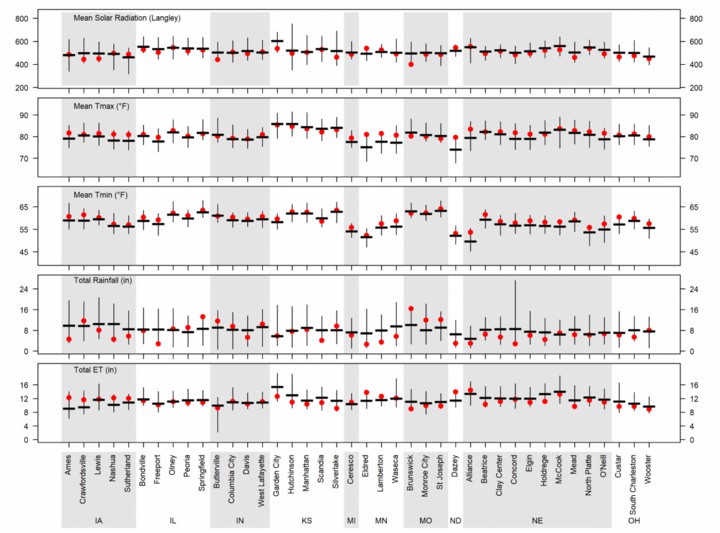
| Location | Water regime | Long-term average yield (bu/ac) § | Range of Yp forecasts as of Jul 14 (bu/ac)¶ 25th | Range of Yp forecasts as of Jul 14 (bu/ac)¶ 75th | Probability (%) of 2021 yield to be: Below (relative to the long-term Yp)† | Probability (%) of 2021 yield to be: Near (relative to the long-term Yp)† | Probability (%) of 2021 yield to be: Above (relative to the long-term Yp)† | Simulated current crop stage* | |
|---|---|---|---|---|---|---|---|---|---|
| NE | Alliance | Irrigated | 193 | 188 | 222 | 3% | 59% | 38% | V14 |
| Beatrice | Dryland | 162 | 107 | 168 | 68% | 13% | 19% | R1, Silking | |
| Irrigated | 230 | 216 | 247 | 6% | 81% | 13% | R1, Silking | ||
| Clay Center | Dryland | 160 | 64 | 149 | 72% | 15% | 13% | V16 | |
| Irrigated | 245 | 235 | 257 | 13% | 72% | 15% | V18 | ||
| Concord | Dryland | 177 | 88 | 142 | 79% | 10% | 10% | V16 | |
| Irrigated | 249 | 232 | 265 | 18% | 72% | 10% | V18 | ||
| Elgin | Irrigated | 252 | 229 | 263 | 15% | 76% | 9% | V16 | |
| Holdrege | Dryland | 115 | 84 | 131 | 36% | 30% | 33% | V16 | |
| Irrigated | 242 | 225 | 261 | 12% | 73% | 15% | V16 | ||
| McCook | Dryland | 88 | 68 | 117 | 31% | 23% | 46% | V18 | |
| Irrigated | 225 | 211 | 235 | 18% | 72% | 10% | V18 | ||
| Mead | Dryland | 183 | 118 | 190 | 59% | 28% | 13% | V18 | |
| Irrigated | 235 | 217 | 247 | 21% | 64% | 15% | R1, Silking | ||
| North Platte | Dryland | 91 | 43 | 99 | 56% | 21% | 23% | V14 | |
| Irrigated | 234 | 223 | 260 | 13% | 51% | 36% | V16 | ||
| O'Neill | Irrigated | 227 | 205 | 239 | 25% | 61% | 14% | V16 | |
| IA | Ames | Dryland | 231 | 176 | 203 | 82% | 18% | 0% | R1, Silking |
| Crawfordsville | Dryland | 230 | 224 | 246 | 10% | 71% | 19% | R1, Silking | |
| Lewis | Dryland | 209 | 197 | 239 | 26% | 39% | 35% | V18 | |
| Nashua | Dryland | 229 | 188 | 206 | 75% | 25% | 0% | V18 | |
| Sutherland | Dryland | 211 | 187 | 218 | 28% | 62% | 9% | V16 | |
| IL | Bondville | Dryland | 235 | 225 | 266 | 17% | 48% | 34% | V18 |
| Freeport | Dryland | 213 | 143 | 195 | 65% | 35% | 0% | V16 | |
| Olney | Dryland | 189 | 192 | 233 | 6% | 35% | 58% | R1, Silking | |
| Peoria | Dryland | 210 | 212 | 240 | 4% | 61% | 36% | V18 | |
| Springfield | Dryland | 178 | 210 | 237 | 0% | 14% | 86% | R1, Silking | |
| IN | Butlerville | Dryland | 225 | 198 | 238 | 33% | 61% | 6% | V16 |
| Columbia City | Dryland | 224 | 212 | 241 | 17% | 67% | 17% | V16 | |
| Davis | Dryland | 231 | 222 | 242 | 0% | 100% | 0% | V14 | |
| West Lafayette | Dryland | 238 | 228 | 261 | 0% | 72% | 28% | V18 | |
| KS | Garden City | Irrigated | 219 | 200 | 228 | 14% | 80% | 6% | V18 |
| Hutchinson | Dryland | 100 | 68 | 113 | 45% | 29% | 26% | R2, Blister | |
| Manhattan | Dryland | 135 | 104 | 165 | 47% | 17% | 36% | R1, Silking | |
| Scandia | Dryland | 132 | 19 | 81 | 91% | 6% | 3% | V16 | |
| Irrigated | 225 | 209 | 248 | 11% | 63% | 26% | V18 | ||
| Silverlake | Dryland | 140 | 138 | 174 | 3% | 40% | 57% | R1, Silking | |
| Irrigated | 210 | 186 | 224 | 29% | 54% | 17% | R1, Silking | ||
| MI | Ceresco | Dryland | 177 | 168 | 231 | 10% | 40% | 50% | V14 |
| MN | Eldred | Dryland | 115 | 12 | 47 | 100% | 0% | 0% | V12 |
| Lamberton | Dryland | 215 | 158 | 195 | 71% | 29% | 0% | V16 | |
| Waseca | Dryland | 219 | 202 | 234 | 22% | 56% | 22% | V16 | |
| MO | Brunswick | Dryland | 181 | 188 | 218 | 5% | 52% | 43% | V18 |
| Monroe City | Dryland | 172 | 192 | 233 | 0% | 25% | 75% | V18 | |
| St Joseph | Dryland | 165 | 186 | 220 | 14% | 5% | 81% | V18 | |
| ND | Dazey | Dryland | 113 | 2 | 78 | 92% | 4% | 4% | V12 |
| OH | Custar | Dryland | 208 | 198 | 227 | 17% | 61% | 22% | V16 |
| South Charleston | Dryland | 216 | 191 | 228 | 32% | 48% | 19% | V16 | |
| Wooster | Dryland | 210 | 210 | 239 | 6% | 58% | 36% | V14 |
§Long-term (last 20+ years) potential yield at each location and surrounding area.
¶ Range of forecasted 2021 potential yields based on average planting date in 2021, indicating the potential yields in the 25th and 75th percentile of the potential yield distribution (associated with respective adverse and favorable weather scenarios during the rest of the season).
† Probability of obtaining a 2021 yield below (10%) than the long-term potential yield at each location.
Simulated Corn Stage Across 40 Locations
Corn has reached silking in Kansas, southeastern Nebraska, and southern Iowa and Illinois. In the rest of the region, corn is still in vegetative phases but it is expected to reach silking soon, especially in NE, IA, IL, IN and MO (Figure 2). Most locations are similar to or slightly behind last year’s corn development by July 14.

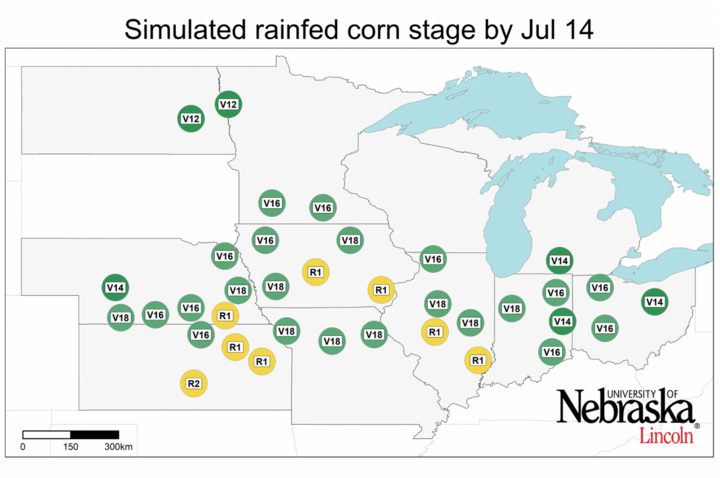
Irrigated Corn: High Probability of Near-average Yields
The range of forecasted irrigated corn yield potential for each location, as well as the probabilities for yields above, near, or below average are shown in Figures 3 and 4. Although it is still too early in the season, there is a relatively high probability of near-average yields for all sites. There is a high probability of near-average yield (>75%, that is, a chance of three out of four) at three sites in southcentral NE and one site in western KS. Weather conditions during the rest of the growing season will determine if most irrigated sites will have near-average yield potential.
Variable 2021 Forecasted Corn Yield Across Rainfed Locations
Forecasted yield potential is highly variable across rainfed sites (Figures 3 and 4). Overall, at this point of the season, probability of near-average yield is relatively high towards the eastern fringe of the Corn Belt (southeastern IA, IL, IN and OH). In contrast, below-average yields probability increases towards the western and northern fringes of the region due to a combination of low precipitation and high temperature. Along these lines, there is a high probability of below-average yield (>75%) at five sites distributed across ND, MN, IA, eastern NE, and northern KS. This projection may change depending on precipitation and temperature during the rest of July and August. Similarly, yields can be higher than predicted here in fields with water table as the latter can help buffer against rain-free periods. Finally, there are three sites in the southern fringe of the region (St. Joseph, MO, Monroe City, MO, and Springfield, IL) where there is a high probability (>75%) of above-average yield due to higher rainfall.
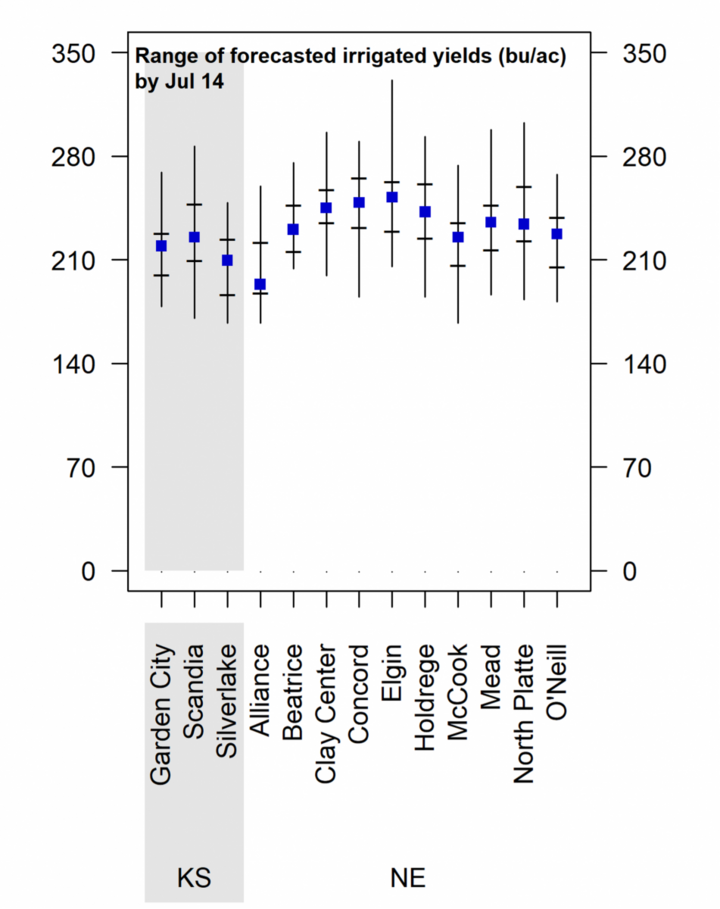

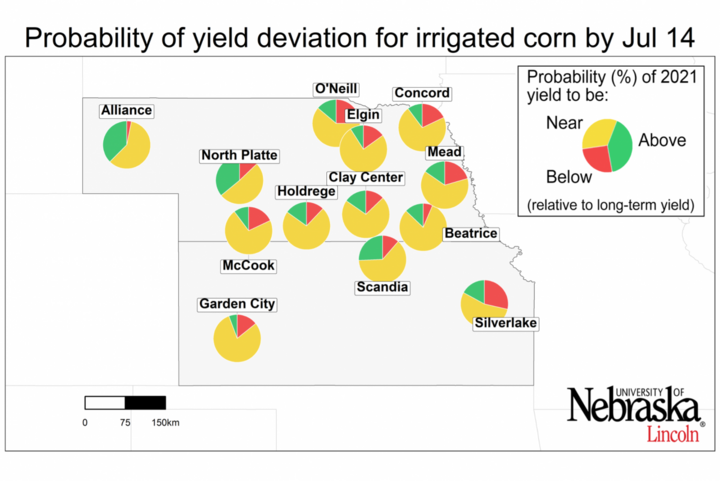
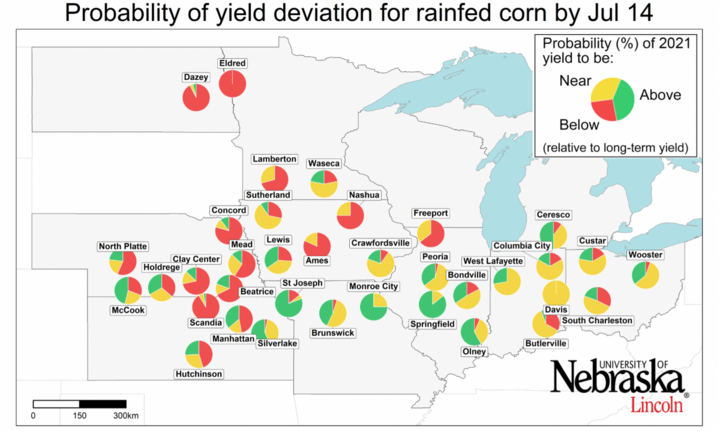
Conclusions
The probability for a “record yield year” for the whole country seems low considering that the probability for above average yield is small (
For rainfed corn, the scenario is diverse across regions, with higher probability of below-average yields in the north and western fringe of the region due to the limited rainfall over the past two months. Temperature and rainfall during the rest of July and early August will likely define the trend for all sites across the region. These forecasts do not take into consideration problems with stand emergence, hail/flooding damage, replanting situations, disease, or nitrate leaching. In fields negatively affected by these constraints, actual yields will be lower than estimates provided here.
It is important to keep in mind that yield forecasts are not field specific and, instead, represent an estimate of average on-farm yield for a given location and surrounding area in absence of the yield-reducing factors mentioned here. Likewise, crop stages and forecasted yields will deviate from the ones reported here in fields with planting dates or hybrid maturities that differ markedly from those used as the basis for the forecasts. We will follow up with further forecasts in early August.
